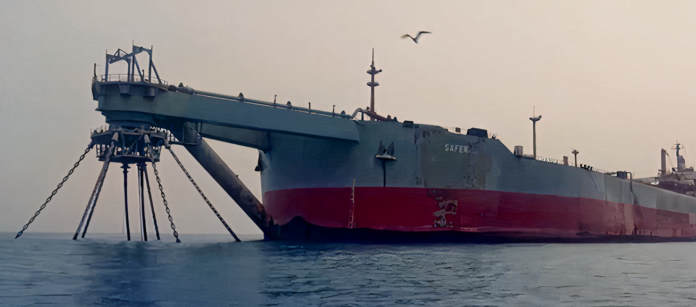The FSO Safer is a single-hulled oil tanker that is going nowhere while rusting away in the Red Sea off the coast of Yemen. The oil onboard may already be contaminated by seawater. The tanker has been there since 2015. The United Nations (UN) is coordinating the raising of $80 million dollars (US) to put into play a plan to secure the vessel and offload its cargo of oil before the ship breaks apart. The concern is the coming fall weather and the current advanced state of decay of the vessel. The potential environmental catastrophe would far exceed the Exxon Valdez oil spill of 1989 off Canada’s West Coast. As of late June, the UN was still $20 million dollars short of the money needed to execute the plan.
Storing oil in decommissioned tankers has been an ongoing industry practice. It’s a marketing ploy by oil traders who purchase during periods of low prices and hold onto the oil until demand and prices rise. Craig Pirrong, a finance professor at the University of Houston is quoted in an article appearing in Exploring Hydrocarbon Depletion stating, “It is one of the easy ways to make money” and “a countercyclical source of profit” for big oil companies and traders around the world. But this practice is ongoing and a danger to the environment with tens of millions of barrels of oil sitting on ships with skeleton crews or none at all for long periods of time. There are times when as much as 100 million barrels of oil are afloat and going nowhere. Each vessel is a potential environmental threat. For that reason alone, not just the ongoing profiteering, the practice should be outlawed.
In the case of the FSO Safer, it has been seven years. What does the prefix FSO mean? It isn’t a registry designation but rather an acronym that is short for Floating Storage Offshore or Floating Storage and Offloading.
The Safer isn’t intended to go anywhere. It’s just an oil tank rusting in warm salt water for the last seven years without maintenance. It is single hulled which is a safety issue in itself. It is 376-metres (1,233 feet) in length and was constructed in 1976 not to be a stationary offshore oil tank. Its international registration numbers are IMO 7376472 and MMSI 473111194. It is currently registered under the flag of Yemen, but in its first decade, it sailed as the Esso Japan which suggests ties to ExxonMobil or one of its subsidiaries. In 1986 it became an FSO and that’s when the flag of registration passed to Yemen. Why hasn’t it been maintained for the last decade? Blame the war in Yemen.
Flying under the Yemen flag means that the country bears responsibility for the ship, its cargo, crew, and the waters around it. But in this case, the registration is called a flag of convenience for the owners of the ship and its cargo because Yemen’s ability to oversee the vessel is virtually nonexistent. With the country in the midst of a prolonged civil war, an extreme drought, a pandemic, and profound food insecurity for its population with thousands dying from disease and starvation, Yemen, today, is a failed state.
That’s why the UN has taken on the task of organizing an international response with The Netherlands ($30 million already donated) in a leadership role to raise the $80 million total needed to implement a plan which involves:
- Providing a second ship as a temporary FSO.
- Transferring the oil from the Safer to that ship.
- Offloading the oil to onshore storage where it can be assessed for contamination and later processed for sale.
- Towing the Safer to a shipyard for salvage.
Both sides in the Yemen civil war support the plan. It’s the money that is missing. And without the money, the plan will not be executed. What that potentially means is an environmental disaster for the Red Sea, both flora and fauna, and for the countries along its shore that will have to deal with the contamination that washes ashore. The UN has estimated the cost of the clean-up could be as high as $20 billion. But the impact beyond the cost on coral reefs, fish, and the mangroves that line the shorelines of the Red Sea and protect them from erosion would be significant. Shipping disruptions would be likely as well from the Indian Ocean through the Strait of Bab al-Mandab and all the way back to the Suez Canal.
Canadian environmental groups have sent a letter to Prime Minister Justin Trudeau and Canadian Parliamentarians urging the federal government to help by donating $10 million to help get to the $80 million goal.
The signatories to this open letter include the Greater Victoria Climate Hub, Canada’s Climate Action Network, ClimateFast, Citizens’ Climate Lobby Canada, the Ontario Climate Emergency Campaign, Greenpeace Canada, the Canadian Association Physicians for the Environment, Fridays for Future, 350 Canada, the Seniors for Climate Action Now, and others. So far the government has no plans to contribute.
Imagine if the Safer was anchored 16 kilometres off English Bay and the Vancouver harbour on Canada’s West Coast, or in mid-Lake Ontario within sight of the City of Toronto skyline, would the government hesitate to act?
The oceans of the world know no borders. Canada, as a rich nation in the Global North, can help to stop what would be a disaster of consequence for the entire planet.









[…] oil in decommissioned tankers has been an ongoing industry practice,” he writes. The practice “is ongoing and a danger to the environment, with tens of millions of barrels of […]
[…] August of last year I posted a story about an oil tanker with 1.1 million barrels aboard that is sitting rusting away off Yemen’s […]